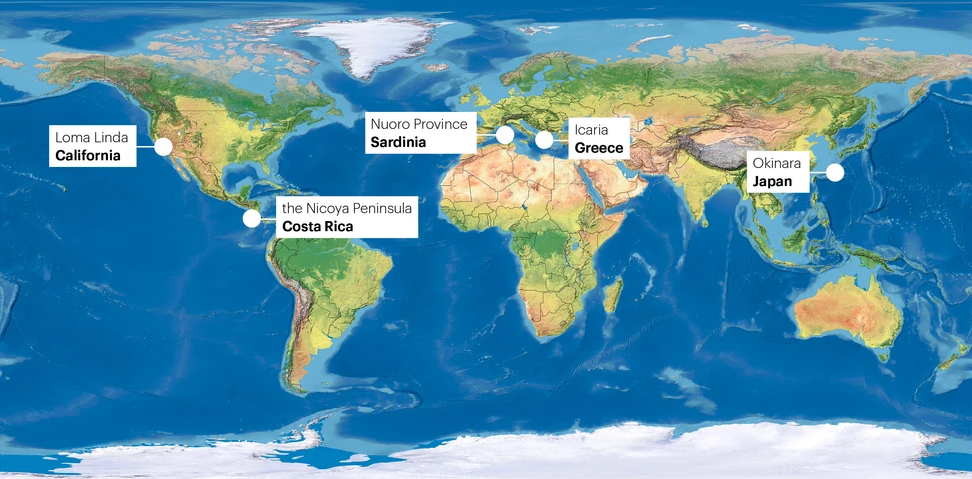
You may have heard of something called a blue zone in the past few years and you’re wondering what it is and what it could mean to you. You’re not alone with those thoughts. While it may not mean much to a person in his or her 20s, it takes on significant meaning as we get older and begin to think about how the environment affects our overall health and wellbeing. That’s when these areas come into play and most people want to find out why they exist and what they offer to the people living within them.
To put it in the most simplistic terms, a blue zone is an area of the world with a life expectancy that’s longer than other places. Blue zones are typically defined as having expectancies with at least a decade longer than the rest of the world. If the average male life expectancy across the globe maxes out at 73, a blue zone is an area with an expected age of 83 or older. Many of these blue zones rocket past that ten years of difference and people have been trying to figure out why it’s happening. If science can figure out why you can live longer in a blue zone, it should be able to raise the average life expectancy around the world, and that’s something we can all benefit from.
History of the Blue Zone
Blue zones got their start in 1999 when a study of people living in Sardinia returned some interesting data. It turned out that, in every 10,000 people living there, they found 13 centenarians. A centenarian is a person who reaches the age of 100, so finding that many in such high numbers was very unusual. To put that into context, Sardinia had a population of 1.6 million people in 1999. Of that population, there were at least 2,080 people at or over the age of 100.
To put that into perspective, the city of Philadelphia, Pennsylvania has a similar population of about 1.6 million people. Out of that population, only 549 of them are known to be at or over the age of 100. That’s almost a quarter of the number of centenarians in Sardinia and that’s a very big difference when you’re looking at science. That’s why it became so important to continue gathering data about centenarians and it turned out there were a few other places where the same numbers could be found.
Blue Zone Locations
There are five locations said to be blue zones around the world with other places being studied to see if they meet the criteria. There are a few things these places have in common with each other, but the first is that they all happen to be in the northern hemisphere. It’s anyone’s guess as to why that’s the case, but no blue zones have been found below the equator to date. The other thing they have in common is that these locations have mountainous terrain, as opposed to flat.
Only one blue zone has been identified in the United States and it’s Loma Linda, California. It has a population of 24,791, as of 2020, and is growing right now. Its name is Spanish for “beautiful hill” and it was incorporated in 1970, making it a relatively newborn when it comes to United States cities. Other examples of blue zones are Nuoro Province, Sardinia mentioned previously, Okinawa Prefecture, Japan, Nicoya Peninsula, Costa Rica, and Icaria, Greece. All places are mountainous and they’re all north of the equator. Other than that, they vary as much as the people who live in them.
Dan Buettner

Now that we’ve defined blue zones, we have to talk about the guy who turned them into a thing. Dan Buettner is an author and explorer who spends a lot of time researching longevity and giving talks on what he finds, although he’s not the one who discovered blue zones. That was the professor emeritus at Université Catholique dr Louvain, in Belgium, and his name is Michael Poulain. He also studies longevity and he’s the one who proposed the blue zones mentioned in this piece. It’s a study that could have gone unnoticed if it hadn’t been adopted by Buettner.
Dan worked with National Geographic on several blue zone ventures and managed to turn out lots of books at the same time. The Blue Zones: Lessons for Living Longer From the People Who’ve Lived the Longest, was published in 2008, Thrive: Finding Happiness the Blue Zones Way, was published in 2010, and The Blue Zones Solution: Eating and Living Like the World’s Healthiest People, came out in 2015. His latest book was published in 2019 and was titled The Blue Zones Kitchen. It’s also of note that Dan promotes plant based diets and holds Guinness records for cycling.

Blue Zone Factors
The National Library of Medicine has taken a look at blue zones that they’ve come up with some data that seems to connect all of them. They start off with the findings of The Danish Twin Study that states only 20% of a long-life span is dictated by genes. The other 80% comes from your environment and lifestyle. That means blue zones are a big part of what makes centenarians, and they spend some time looking at Dan’s research to figure out what makes these locations so successful in making old people.
Activity
First up is activity and it’s not what you think. It turns out that the oldest people in the world don’t really exercise. Instead, they simply live lifestyles that keep them active. As they put it: “In blue zones, Buettner’s team observed that people were nudged into moving about every 20 minutes. For example, they were gardening, they kneaded their own bread, and they used hand-operated tools; their houses were not full of conveniences. When they did go out (e.g., to school, work, a friend’s house, a restaurant, or to socialize), it was almost always on foot. Movement is engineered into their daily lives.”
Outlook
Then we get to the centenarians’ outlook on life and how they go about their mental states. These men and women have just as much stress as you have, but they handle it differently. Stress brings on lots of bad things, like inflammation and the risk of heart disease. These long-lived people have activities in their lives that work to reduce it. The activities include things like napping, prayer, veneration of their ancestors, and happy hour. However, before you start sleeping for 12 hours a day, just to wake up and drink for the rest of it, remember that this is all done in moderation, not to excess.
Then there’s a sense of purpose in their lives. As stated before at OnOurWayTo100, it’s incredibly important to have purpose as we age. It gives us something to live for and keeps us from spending our time alone and sedentary. A study followed 6,000 people for 14 years and found that purpose really helped to keep them going. In fact, they found that people who could tell them what their life’s purpose happened to be had a 15% lower risk of dying and that’s saying a lot.
Diet
You can never underestimate the effect that diet has on your longevity and these blue zones mostly have a few things in common. The first is that people inside them drink moderate amounts of alcohol. Most have between 2 and 4 glasses of wine a day, but not all of them. One blue zone doesn’t get any alcohol, but we’ll talk about that one a little later. Then there’s the solid food they consume. Of the 154 diets considered, a staggering 95% of them were plant based. That infers that going vegan and eating lots of carbs can contribute to a longer lifespan.
Then there’s overeating. Long-lived people simply don’t do it. There’s something called the 80% rule and it’s something the people of Okinawa take very seriously. It states that you should stop eating when you feel 80% full, not 100% full or 120% full. This is done by eating slowly so your brain can feel the food as it fills you up. You can achieve the same thing by eating with family, praying before a meal so you’re not just devouring it, and never watching TV while you eat. The blue zone people also keep breakfast as the largest meal of the day, followed by a smaller lunch with dinner being the smallest of all meals.
Connections
It’s also important to be surrounded by other people. People over the age of 100 spend a lot of time with friends and family and they have tribes that they can consider to be a large part of their lives. They also have large faith-based communities that they can rely on. If you can belong to a group, then you’re more likely to live a longer life and that’s something that appears to be the case all around the world.
Controversy

Now that we know why blue zones exist, we can talk about why they might not. There’s been no lack of controversy surrounding the claims, but the most important one is the lack of scientific evidence to back it up. While there have been studies on them, there’s little in the way of real evidence. Most of it comes from information that can’t be repeated and that’s a pillar of scientific discovery. There’s also one big dip in the life expectancy of blue zones and it rests squarely on Okinawa. This Japanese prefecture has seen a major decline in the number of people at or over the age of 100 in the past century. In fact, it’s now rated as the 26th largest community out of the 47 prefectures that make up Japan.
There’s also a lack of controlled studies in these areas. In order to make it scientifically viable, it has to be controlled and that hasn’t happened. Studies would have to have control groups in the areas as well as repeatable tests to make it acceptable. As it stands, the scientific community can only look at this data as speculation and nothing more.
Money and Blue Zones
Finally, we got to the thing that makes the world go ‘round. There’s a decent amount of money on the line for proponents of blue zones and that should never come as a surprise. Dan Buettner not only has plenty of books on the subject, he also copyrighted the term “blue zone”. He also has a TV mini-series titled Live to 100: Secrets of the Blue Zones, that was released in 2023. On top of that, he established a marketing company called Blue Zones, LLC when he added Loma Linda to his list of locations in 2008.
What makes Loma Linda special is that it’s a Seventh Day Adventist community and is the only blue zone where alcohol is prohibited. They claim their close-knit and faith-based way of life is what produces so many centenarians, but there’s more to the story. They purchased Blue Zones LLC from Dan in 2020 through their health care system, Adventist Health. That means they get to sell it and profit from it as a way to live a healthy lifestyle. That, coupled with the lack of strong scientific data, throws up some big red flags. Whenever a group of people has a lot to gain by selling you something, no matter what that something happens to be, you should be wary of it.
Conclusion
So that’s pretty much the rundown for blue zones. There are five places around the world with more long-lived people than others. That could mean something, or it could all be a bunch of bunk. People are making money off the concept, but that doesn’t immediately mean it’s all fake. The percentage of centenarians blows away other communities and that means something. Okinawa, however, isn’t maintaining it any longer. It all boils down to what you can take from it. In this case, live an active lifestyle, spend time with friends and family, and don’t be afraid to enjoy some wine. Even if you don’t live to be 100, you’ll have a good time with whatever lifespan you have left!
